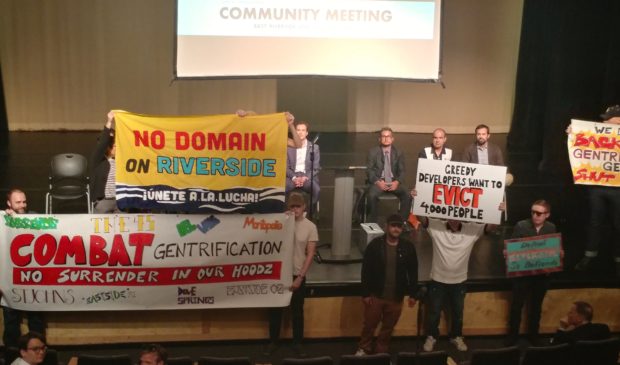Seven protesters arrested, public expresses opposition at community meeting for Project Catalyst
Thursday, March 28, 2019 by
Jessi Devenyns Anticipating a situation similar to last month’s Planning Commission meeting, Assistant Planning and Zoning Director Jerry Rusthoven opened the March 27 community meeting to discuss Project Catalyst with a word of caution.
“It’s important to us that this meeting be conducted in a civil manner,” he said.
Nevertheless, several dozen protesters from Defend Our Hoodz, or Defiende el Barrio, climbed onto the stage and filled the aisles of the George Washington Carver Museum & Cultural Center auditorium, chanting and yelling profanities at city staff.
Particular vehemence was directed at Michael Whellan, the agent for the developer who initiated the zoning case for the major mixed-use development proposed near East Riverside Drive and Pleasant Valley Road.
While the protesters were chanting “Defend our hoodz/we don’t back down/gentrifiers get shut down,” a dozen police officers arrived and issued a warning that they would make arrests for trespassing if the protesters did not leave the premises.
The warning was met with louder chants, blaring horns and taunts that the officers were being filmed in case of inappropriate conduct. Amid the cacophony, officers arrested seven individuals.
There was no violence, but the Austin Police Department later informed the Austin Monitor that they had undercover cops on-site in case the protest got out of hand before the uniformed officers could arrive.
Defend Our Hoodz told the Monitor in an emailed statement that although protesters were expressing anger, it was done peacefully and that “community members simply stood with signs and spoke against the project.” It was their view that “the city of Austin protects developers but arrests community members opposed to them.”
Once the remaining protesters had moved outdoors, the meeting recommenced with a brief overview of the project and an explanation of why the development would require the city to employ Chapter 26 of the Texas Parks and Wildlife Code, a provision that allows the Austin Transportation Department to extend a road through public parkland.
According to Upal Barua, a review manager with the Transportation Department, the road would need to take 11,000 square feet of parkland from Roy G. Guerrero Park.
Speakers from the community were particularly concerned about the loss of public parkland. Ethan Judd, an environmental sciences student from the University of Texas, noted that paving more impervious cover in this area will exacerbate the existing erosion problem and could possibly lead to another sediment-filled water crisis like the city experienced last October.
Both Linda Guerrero and Pam Thompson of the Environmental Commission expressed concern that the project had not passed through their commission or the Watershed Protection Department for review.
Local activist Susana Almanza said that taking public parkland was only necessary due to the development bringing an additional 6,000-8,000 people to that area, a number the current roadways cannot support according to a traffic feasibility study.
Update: In a comment to the Austin Monitor, Whellan explained that “The road plan for this area was approved by the City of Austin back in 2013, as part of the East Riverside Corridor Master Plan – with the goal of improving neighborhood connectivity…While this piece of parkland was always envisioned as part of the future Lakeshore Boulevard, these property owners propose adding more than 10 acres of additional parkland. Overall, it’s a big net win from a parkland perspective.”
Almanza also emphasized the fact that the development would remove 1,300 affordable housing units, a concern that brought applause from the audience and was echoed by many subsequent speakers.
Whellan explained that 8-12 percent of the units will be made affordable at 60 percent of the median family income if the zoning case is approved. The project is currently slated to begin in 2023 and be completed by 2043.
None of the speakers from the community expressed support for the development.
Daniel Llanes, a community organizer and chair of River Bluff Neighborhood Association, summed up the sentiment bubbling through the crowd, saying that the people he represented felt that Project Catalyst exemplified “The richest people playing Monopoly with the rest of our lives.”
The Austin Monitor’s work is made possible by donations from the community. Though our reporting covers donors from time to time, we are careful to keep business and editorial efforts separate while maintaining transparency. A complete list of donors is available here, and our code of ethics is explained here.
You're a community leader
And we’re honored you look to us for serious, in-depth news. You know a strong community needs local and dedicated watchdog reporting. We’re here for you and that won’t change. Now will you take the powerful next step and support our nonprofit news organization?




